New Approaches Lead to More Choices in Multiphysics Analysis
There is more than one way to attain the cross-disciplinary analytical functionality required by multiphysics and multidisciplinary applications.
Latest News
October 1, 2008
By Tom Kevan
Many conventional modeling strategies are based on single physical descriptions and cannot work simultaneously with multiple physical phenomena or models in an integrated fashion. Yet, the simulation of individual physics is no longer adequate for many of the advanced problems and applications confronting the engineering simulation community. Designers and engineers need a unified simulation environment in which to evaluate the different physics their designs incorporate under real-world conditions. These physics involve the interaction of such phenomena as fluid flow, acoustics, structural mechanics, heat transfer, and electromagnetics.
“This is a major challenge,” says Barbara Hutchings, director of partner relations at ANSYS. “The need is clearly to do cross-disciplinary analysis. If you look at the tools that have been available, it’s typically been isolated products from independent vendors that may provide some level of interoperability, in terms of file transfer. But each independent tool has been built to do its specific purpose and has not been architected from a central, integration-minded approach.”
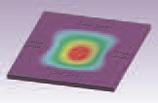 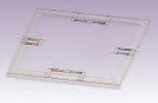  Figure 1: Design engineers need to be able to accurately predict how complex products will behave in real-world environments in which multiple types of coupled physics interact. Technology from ANSYS incorporates a wide variety of multiphysics analyses. The broad range of capabilities provided by these elements is essential for the design ofmany products, such as this micro-electro-mechanical systems (MEMS) pressure transducer. The images illustrate diaphragm deformation (left), electric potential (center), and equivalent stress (right). Images courtesy of ANSYS, Inc. |
Conventional Options
One way to get the cross-disciplinary analytical functionality required by multiphysics and multidisciplinary applications is to use software from collaborating vendors. In this case, the vendors provide a level of integration through the use of middleware or open APIs, which enables the software packages to communicate and share data.
“We have an arrangement with Abaqus ]SIMULIA], a leading provider of structural codes,” says Dennis Nagy, vice president of business development for CD-adapco. “Initially, we worked together to be able to pass data through a third-party software that allows you to do multiphysics by taking data from a number of different packages, passing it through its neutral translator, and spitting it out in the format for the other package that you are trying to run simultaneously. Now we’re taking the next step of doing that directly, eliminating the middleware by being able to pass the data directly.”
Indirect collaboration takes the form of individual software providers supplying open interfaces. “COMSOL has several interfaces that make it easy to interface COMSOL products with other applications,” says Bernt Nilsson, vice president of marketing at COMSOL. “We offer external interfaces to Java, C, C++, and Fortran. COMSOL also offers the ability to directly read and write file formats from other vendors, and we provide open specifications of our data formats for its models, geometry, and mesh data.”
This approach potentially provides you with the advantage of melding best-in-class software packages, giving you the option to pick the functionality you value most, but it does have limitations. After all, you’re still working in multiple environments.
“Most software vendors — and certainly ANSYS — do their best to provide some level of interoperability with the other tools their customers might be using,” says ANSYS’ Hutchings. “Yet that interoperability is more likely to be file-based. In other words, I hand my files to you, and you pick them up and use them, or vice versa. That file-based integration has some inherent limitations in terms of the integrated process by which the engineers are doing their work. It’s lacking on that side.”
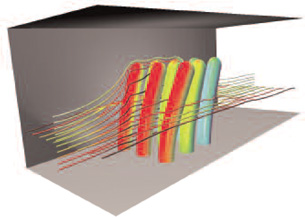 Figure 2: Because all wave propagation is distorted to some degree by damping, this SAW sensor requires sensitivity magnifiers to work more efficiently. In this model generated with COMSOL Multiphysics 3.4’s MEMS Module, the flow around the magnifiers is coupled to the structuralanalysis of their deformation. Image courtesy of COMSOL. |
Single-Source Solutions
The alternative is to use the software of a single provider that offers a variety of types of CAE software, covering a range of disciplines (e.g., FEA, CFD, and electromagnetics). For example, ANSYS is making an effort to bring comprehensive multiphysics under a single adaptive architecture, with an integrated user environment.
“To do this kind of integrated analysis, you need data structures that will talk to each other,” says Hutchings. “You need an integrated user environment, which is not to be underestimated, because dealing with multiple user environments can be very challenging. ANSYS’ vision of this integrated, comprehensive multiphysics capability, all within a scalable, well-architected user environment, is absolutely what’s needed to tackle the problem of multiphysics. All of that does drive toward integrating these disciplines under a single roof.” (See Figure 1.)
ANSYS isn’t the only vendor pursuing this approach. For example, both COMSOL (see Figure 2) and CD-adapco (see Figure 3) offer single-provider environments that offer enhanced integration and deliver “simultaneous” simulation. This capability enables you to run multiple disciplines more closely in sync. Using this functionality, the software packages automatically exchange data more frequently than can be executed by collaborating vendors. The major difference among these environments is the richness and depth of the disciplines offered.
The single-source multiphysics approach simplifies cross-disciplinary analysis by letting the vendor deal with inter-program communications (see Figure 4).
“All analysis products from COMSOL use the same core solvers,” says Nilsson.“These core solvers have the ability to couple applications from different engineering fields, such as fluid dynamics, structural mechanics, electromagnetics, and heat transfer. Using our technology, users do not need to concern themselves with integration issues of different solvers, with various input and output formats.”
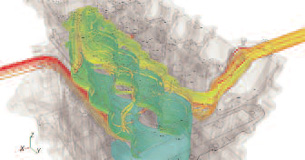 Figure 3: This image shows the combined flow and thermal analysis of an engine block. Automatic polyhedral meshing in STAR-CCM+ enables fully conformal fluid-solid interfaces for simultaneous solution of fluid, solid flow, and thermal fields. It eliminates the mapping process traditionallyused to transfer fluid-solid interface temperatures to FEA solvers. Image courtesy of CD-adapco. |
A Service-Oriented Architecture
A third cross-disciplinary analysis approach borrows elements from the first two approaches discussed here, letting you use code from multiple vendors in combination or rely solely on a single vendor’s stable of integrated software applications. The mechanism that enables this third approach and integrates all participating technologies is service-oriented architecture (SOA).
Service orientation breaks applications down into individual functions and processes, called services. These are made available over a network, and you can combine and reuse services as building blocks to create new processes. Services communicate with each other by passing data from one service to another or by coordinating an activity between two or more services.
MSC.Software has built its open, multi-discipline simulation architecture (OMD–SA) around the SOA methodology. Essentially this allows you to integrate functions and processes of multiple CAE software packages into a new application, regardless of vendor or discipline.
“Under this umbrella of multidiscipline, the idea is that we can componentize pieces of technology and make them work together,” says Peter Mendoza, director of solutions marketing at MSC.Software. “Therefore, we’re using the best-in-class technology for a specific application. So we are using the best contact, for example, or the best motion and combining all these things under this multidiscipline umbrella. The real value is being able to make all these things work together.”
The OMD–SA supports real-time communications. “Our strategy is about real-time transfer of data, with no loss of data integrity,” says Hal Hikita, director of enterprise computing for MSC.Software. “It goes beyond translation. It’s about streaming data back and forth.”
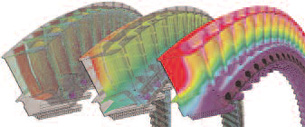 Figure 4: In this simultaneous flow, thermal, and stress solution carried out entirely in STAR-CCM+ for an internally cooled turbine blade, polyhedral meshing technology allows fully conformal meshing of the primary gas path, blade solid, and cooling channels to eliminate the need to mapsolutions between different codes. Image courtesy of CD-adapco. |
“We are offering an open SOA architecture to allow you to integrate with other solutions,” says Mendoza. “We are using the same SOA architecture to integrate our own internal solutions and components together.” (See Figure 5.)
To integrate with MSC.Software’s solutions, the other vendor’s code must support open, multidiscipline simulation architecture’s SOA interface level. “We provide the service, and we agree on the interface that they need to satisfy,” says Mendoza. “As long as they satisfy the interface — meaning they give the information that we agree upon to us, and we give the information that we agree upon back to them — then that is all that really needs to happen.”
Sequential Simulation vs. Co-Simulation
The evolution of advanced coupled-physics technology is marked by a decline in the use of sequential simulation and an increasing presence of simultaneous simulation, or co-simulation. Sequential simulation involves an almost manual exchange of data by participating solvers. For example, you might use FEA software to analyze a structure and a CFD application to simulate the flow around it. The flow analysis generates loads on the structure, which you then apply in the structural model. When applied to transient or time-dependent applications, sequential simulation is time-consuming and cumbersome.
The problem here is timing. “In the real world, what happens is that those two regimes are operating together,” says MSC’s Mendoza. “The fluid part is putting load on the structural part, but then the structural part is reacting to the load at the same time.”
To be able to optimally address time-dependent, nonlinear multiphysics or multidisciplinary applications, you should be able to perform simultaneous simulation, or co-simulation to simulate two different physical phenomena at the same time. Communications are integrated to a greater extent and data sharing is more seamless.
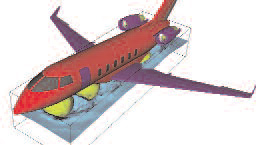 Figure 5: The application simulates an aircraft crash landing on water cushioned by airbags. This multi-discipline simulation architecture (OMD–SA) is built around the service-oriented architecture methodology.Image courtesy ofMSC.Software. |
A Question of Choices
When beginning a multiphysics application, you have several options for integrating the multiple disciplines required to perform the analysis. Many single-provider options rely on middleware or open APIs to enable communications.
While these technologies deliver file sharing, the resulting process is sequential simulation. Enhanced single-vendor environments and SOA-based systems enable simultaneous simulation, or co-simulation, which more accurately reflects the real-life interactions of the physics involved.
Demands of the engineering simulation industry are driving ongoing efforts to improve integration in multidiscipline analysis. You may not be able to avoid choosing one approach over another, but the constantly evolving technology precludes a long-term solution. Something new and better is just over the horizon.
More Info:
ALGOR, Inc.
Pittsburgh,PA
algor.com
ANSYS
Canonsburg,PA
ansys.com
Blue Ridge Numerics
Charlottesville,VA
cfdesign.com
CD-adapco
Melville,NY
cd-adapco.com
COMSOL
Burlington,MA
comsol.com
COSMOS
Concord,MA
cosmosm.com
Dassault Systèmes
Suresnes,France
3ds.com
MSC.Software
Santa Ana,CA
mscsoftware.com
NEi Software
Westminster,CA
neinastran.com
Siemens PLM Software
Plano, TX
plm.automation.siemens.com
SIMULIA
Providence,RI
simulia.com
Contributing Editor Tom Kevan is a New Hampshire-based freelance writer specializing in technology. Send your comments about this article to [email protected].
Subscribe to our FREE magazine, FREE email newsletters or both!
Latest News
About the Author
DE’s editors contribute news and new product announcements to Digital Engineering.
Press releases may be sent to them via [email protected].






